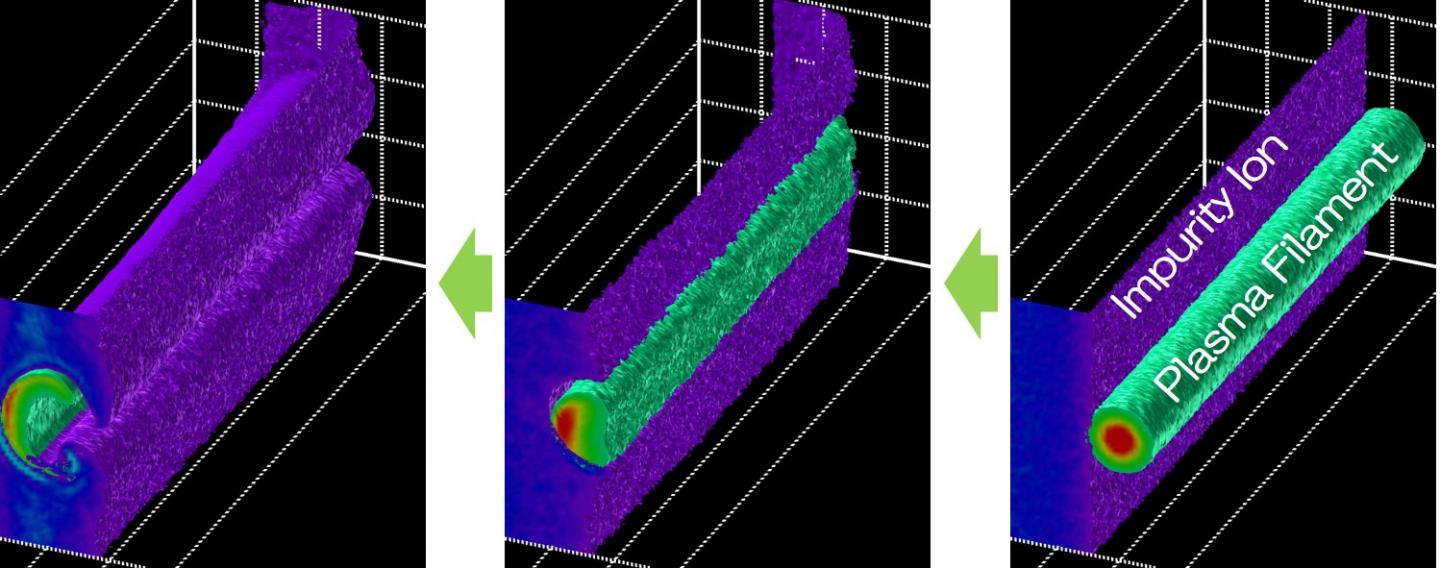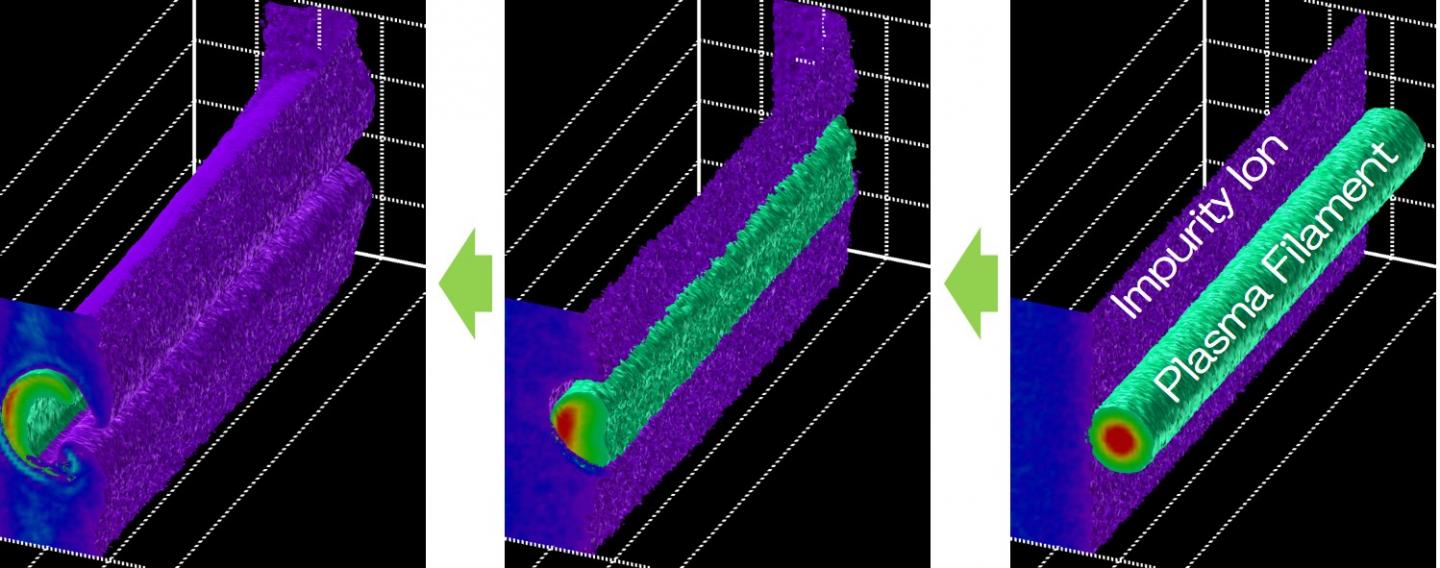
Credit: Dr. Hiroki Hasegawa
Background to the Research
The generation of fusion energy utilizes the fusion reaction that occurs inside a high-temperature plasma. In order to achieve the generation of fusion energy, we confine plasma in the magnetic field with a doughnut configuration. Together with raising the temperature and the density in the plasma's core region, it also is necessary to control the plasma in the edge region which surrounds the plasma. In the edge region of the confined plasma appears the plasma blob. Because this plasma blob moves in the direction of the confinement vessel's wall, there thus is concern that the plasma will come into contact with the wall and the plasma temperature will fall (see Figure 1). In order to control this type of plasma blob, precisely understanding and predicting the blob's movement is one of the important topics in the future achievement of fusion energy. In order to investigate in detail the complicated movements of a plasma blob, computational simulations are necessary. There are several methods for performing simulations of the gathering of particles (ions and electrons) that bear electricity. The most accurate method is that which calculates the movement of each particle that composes the plasma and calculates the electrical field thus produced. In order to accurately understand the behavior of a plasma blob, a simulation from the micro-level (particle level) is required. However, it was extremely difficult to perform such a simulation because an immense amount of calculation is required.
Research Results
Dr. Hiroki Hasegawa and Dr. Seiji Ishiguro, at the National Institute of Fusion Science, using the NIFS Plasma Simulator supercomputer succeeded for the first time in the world in conducting a micro-level simulation of a plasma blob in the "edge region" of the plasma. The Plasma Simulator has the greatest capacity in the world as a supercomputer dedicated to plasma and fusion science use. Here, in addition to newly developing a calculation program by utilizing the Plasma Simulator's capacity, they also were able to calculate the movements of one billion particles. When calculating plasmas of the same size, the number of calculations exceeded 10,000 in comparison with the method used heretofore for calculating the blob's particles as if they were a unit.
According to this simulation, finely detailed analyses that incorporated the influence mutually provided by the movement of particles and the electrical field, which had not been possible in methods used to date, became possible. Further, at the same time as we pursue the movements of a string-like plasma blob from the particle level, we were able to clarify the micro-level internal structure of particle movements inside the plasma and the temperature distribution (see Figure 2). By understanding this type of internal structure, it became possible to investigate the influence of that internal structure upon the movement of a plasma blob. Moreover, we clarified the condition in which a plasma blob carries impurities (see Figure 3).
These research results, together with greatly advancing understanding of the behavior of a plasma blob, have greatly improved prediction accuracy. These research results were reported at the 26th International Atomic Energy Association (IAEA) Fusion Energy Conference held in Kyoto, Japan from October 17-22, 2016. The results have also been highly evaluated, and later were presented as an invited lecture at the thirty-third annual meeting of The Japan Society of Plasma and Nuclear Fusion Research in Sendai, Japan, held from November 29 to December 2, 2016, where the research results also garnered much attention.
###
Vocabulary
1. Simulation from the micro-level
Through a simulation based on a fluid model where we understand a plasma as a whole, we can know the general behavior of a plasma through a small number of calculations. However, we cannot replicate the phenomenon that is caused by the movement of plasma particles. From the movements of all individual particles that comprise a plasma and the method for calculating the electrical field that is produced by those particles (simulation from the micro-level) we can trace the plasma's general behavior. This is compared to the following. We construct a simulation in which we follow all of the monetary transactions of every citizen in a country of one billion people. Then we can grasp the flow of money throughout the country. However, an immense amount of calculations are required.
2. Impurities
In the edge region, for various reasons impurities are generated (other than hydrogen such as carbon, oxygen, iron, and others), and when impurities enter the core plasma, the problem of the falling plasma temperature emerges. Understanding the behavior of these impurities and accurately predicting their behaviors, too, is one of the important issues in achieving fusion energy.
3. Velocity distribution
Particles, which are composed of gases such as air, and plasmas have different velocities as they fly about. Depicting the velocity of the particles on the horizontal axis and the number of particles at that velocity on the vertical axis shows the velocity distribution. The width of the velocity distribution represents the temperature. This indicates that the broader is the width the higher is the temperature.
Media Contact
Dr. Hiroki Hasegawa
[email protected]
81-572-582-380
http://www.nins.jp/english/
############
Story Source: Materials provided by Scienmag





